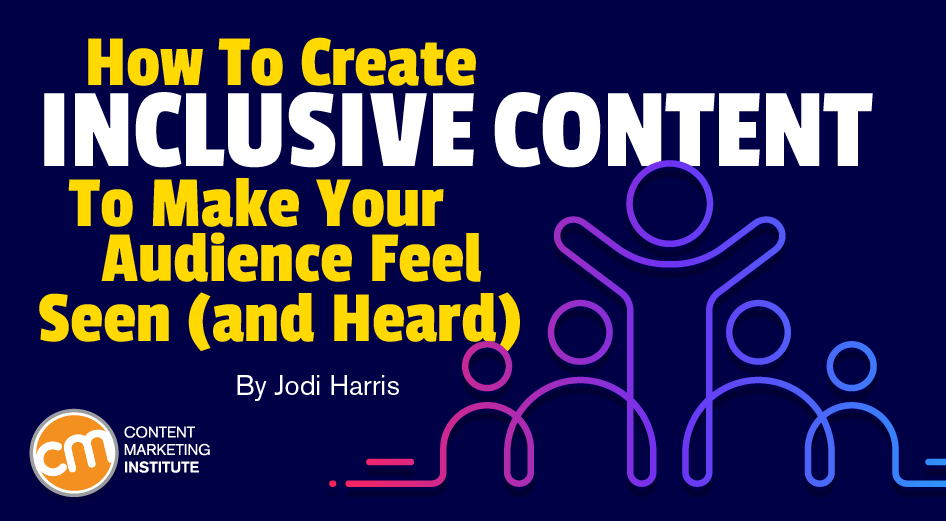For diversity and inclusion to thrive in content marketing, they need to be top of mind in every conversation – the ones brands have publicly and the ones they have internally.
While your content team can’t address all possible perspectives in every content effort, they can make great strides by implementing new thinking and processes and developing “muscle memory” for championing diversity in your content marketing.
We spoke at Content Marketing World with African-American Marketing Association founder Michelle Ngome about integrating diversity and inclusion into a brand’s content marketing. Watch the video below for highlights of that conversation. Then, read on for tips from Michelle to turn her advice into intentional actions that deepen customer engagement and drive business growth.
Start internally
Michelle encourages organizations to start from the inside by examining who gets invited to the decision-making table. “A lot of organizations are diverse, but are they inclusive? Do they have [representation of] Black people, Latinx, Asians, American Muslims, neurodiversity, and people with disabilities involved in their marketing conversations?” she asks. “If so, I would like to think they’ll speak up [to help your brand] avoid things that may be sensitive to [any of those] communities.”
A lot of organizations are diverse but are they inclusive, asks @MichelleNgome via @joderama @CMIContent. Click To TweetThat representation should also extend to those who create the content. If it isn’t possible on your in-house team, Michelle suggests, bringing on a freelance writer or consultant, or partnering with an agency. They can expand your team’s frames of reference and contribute new ideas and perspectives to your storytelling efforts.
If you don’t have the budget to outsource, interview customers or subject matter experts to share their stories and experiences with your content creators, then use your brand’s content platforms to amplify their voices.
Cultivate a welcoming environment
Simply inviting diverse team members to your content planning sessions and strategy meetings isn’t enough. You also need to cultivate an environment where each person feels encouraged and empowered to speak their truth even when it might conflict with the ideas and perspectives held by the majority of the team.
For this, Michelle recommends that team leaders tap into their emotional intelligence and look for ways to make outliers more comfortable expressing their views and experiences.
“It takes a lot of confidence to speak up in a room. If you’re a manager, how are you reading the room? Do you see someone who seems kind of timid? [Engaging them] it might be inviting them to a one-on-one like, ‘Hey, let’s, let’s go to my office’ or ‘Let’s do a 15-minute Zoom call and talk about this.’ They probably do have thoughts – they’re just afraid to speak up,” Michelle says.
Inclusivity often involves managers asking timid team members to talk one-on-one, says @MichelleNgome via @joderama @CMIContent. Click To TweetSpecific and prescriptive multicultural marketing training can also help shift your team’s mindset, making them more aware of their unconscious biases and motivating them to eliminate biased language and ideas from their content.
HANDPICKED RELATED CONTENT:
Audit your brand communication
Michelle also suggests companies do a full audit of their communication to identify areas where unintentional imbalances or subtle exclusions may exist. Examine internal messaging as well as the content across all your digital platforms:
“What kinds of content are you sharing on Instagram, Facebook, LinkedIn company pages, and Twitter? What do your messaging and images look like? Is there a healthy balance of perspectives shared in [your] choices of topics and the [faces and voices behind] your messages? Is the language welcoming to all, or does it prioritize the experiences of some groups over others?”
Exploring aspects like these can identify existing inclusion lapses in your brand communication.
Though content marketers may not have influence over some enterprise-level communication, the team can take steps to counterbalance them with more inclusive messaging in the content they create.
HANDPICKED RELATED CONTENT:
Revamp operational processes
You also can take a few more deliberate steps to implement an inclusive content marketing strategy:
- Add diversity-related categories to your editorial plan: Note such things as the audience segments the content effort might appeal to.
- Gather direct insights: Conduct surveys, host one-on-one interviews, meet with focus groups to learn how a BIPOC customer journey may be different from other targeted audience members.
- Develop a diverse editorial advisory board: Create an ongoing resource to suggest ideas, fresh sources, and speakers from multiple perspectives.
#CMWorld https://t.co/uXfO42fj4F
— Content Marketing Institute (@CMIContent) February 1, 2022
- Watch your language: Don’t simply write or say that your brand is diverse and committed to inclusion. Show your audience by using descriptive words that reflect concepts like “connection,” “openness,” and “balance.” Aim to use gender-neutral phrases (like they or them instead of he and hers) and refer to sources by their chosen pronouns (if you aren’t sure, ask). Where possible, free your content from biased statements that assume a level of wealth or experience that might exclude some of your target audience.
Michelle recommends a few resources to sharpen your inclusive language skills, including her company’s Language of Inclusion Glossary and guidance provided by Diversity and Inclusion Work.
1. The Language of Inclusion DEI Glossary https://t.co/cyA1ri4nsx
2. @CKadala https://t.co/fxPY3WsAom
3. @ongig https://t.co/2PuJoRhoBg
4. @heather_s_olson https://t.co/whM1Umk3zY#CMWorld— Michelle Ngome 🇨🇲 (@MichelleNgome) February 1, 2022
Be open to learning and improving
Brands like people don’t always handle their diversity challenges perfectly. But remember, there’s room for all kinds of businesses to grow more inclusive. It’s also never too late, even for those that have made high-profile errors in judgment, may have been ill-informed about an issue, or placed their bets on the wrong horse.
Cover image by Joseph Kalinowski/Content Marketing Institute

